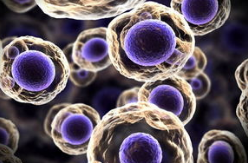- 阅读
- 阅读
- 技巧
- 百科
- 试题
- 文化
- 技能
More evidence that hormone testing for women's fertility does not work.
更多证据表明,检测女性生育能力的荷尔蒙测试并不奏效。
Women seeking to defer motherhood are often encouraged to check their fertility.
人们通常会鼓励希望推迟生育时间的女性检测自己的生育能力。
Though fecundity is tied to age, the effect of time's passage varies.
虽然生育能力与年龄有关,但其对不同人的影响不同。

Time to Conceive looked at 750 women aged between 30 and 44 who were living with a male partner not known to be infertile, had no diagnosis of infertility of their own, and had recently started trying to become pregnant.
“怀孕时间”研究调查了750名年龄在30岁到44岁之间的女性,这些女性都分别与一名没有被诊断为不孕不育的男性伴侣生活在一起,并且最近开始尝试怀孕。
The team took blood and urine samples from these volunteers and measured levels of three hormones often examined by fertility tests.
研究小组从这些志愿者身上采集了血液和尿液样本,并检测了生育测试中经常检查的三种荷尔蒙的水平。
They then followed each volunteer for a year.
然后,他们对所有志愿者进行了一年的跟踪调查。
The upshot, published in 2017, was that hormone levels were uncorrelated with pregnancy within the 12-month window through which the researchers were looking.
2017年发表的研究结果是,在研究人员观察的12个月时间内,荷尔蒙水平与是否怀孕无关。
But perhaps, Dr. Steiner subsequently speculated, that window was too narrow.
但斯坦纳博士随后推测,也许这个时间太短了。
In 2020 she therefore got back in touch with the original participants for a follow-up.
因此,在2020年,她与最初的研究对象重新取得了联系,以便进行后续调查。
She asked them if they would fill out a questionnaire about how many children they had had, how long it had taken to get pregnant and whether they had been diagnosed with infertility.
她询问对方是否愿意填写一份调查问卷,内容包括他们有几个孩子,怀孕用了多长时间,以及他们是否被诊断为不孕不育。
Some 336 of them agreed to participate.
约336人同意填写问卷。
Among these there had been 239 pregnancies, resulting in 225 live births.
其中有239人怀孕,225例为活产。
More sadly, 73 participants were infertile.
悲伤的是,73名研究对象不育。
But the hormone levels in the tests carried out in the original study did not predict these outcomes.
但在最初的研究中,测试的荷尔蒙水平并没能预测这些结果。
There was no difference, the researchers found, between women with poor results and those with normal ones.
研究人员发现,不育的女性和最终生育的女性荷尔蒙水平没有区别。
In the case of one substance, for example - anti-Mullerian hormone, which is thought predictive because it is produced by cells in the egg-bearing follicles of the ovaries, and is thus believed to reflect the number of those follicles - 79% of those with low levels of it went on to give birth.
举一个例子,抗缪勒管激素被认为能够预测生育能力,因为它是由卵巢中有卵子的卵泡中的细胞产生的,因此人们认为它能够反映有卵子的卵泡的数量,而79%抗缪勒管激素低的人能够生育。
That was statistically indistinguishable from the 71% of mothers with normal levels.
荷尔蒙水平正常的女性71%能够生育,这两个数据在统计上相一致。
The decline in fertility, says Dr. Steiner, is thus clearly not related to the decline in the quantity of eggs, but presumably to their quality.
因此,斯坦纳博士说,生育能力的降低显然与卵子数量的减少无关,而可能与它们的质量有关。
And how to measure that remains unknown.
但如何检测卵子的质量仍是个未知数。
来源:经济学人
参与评论